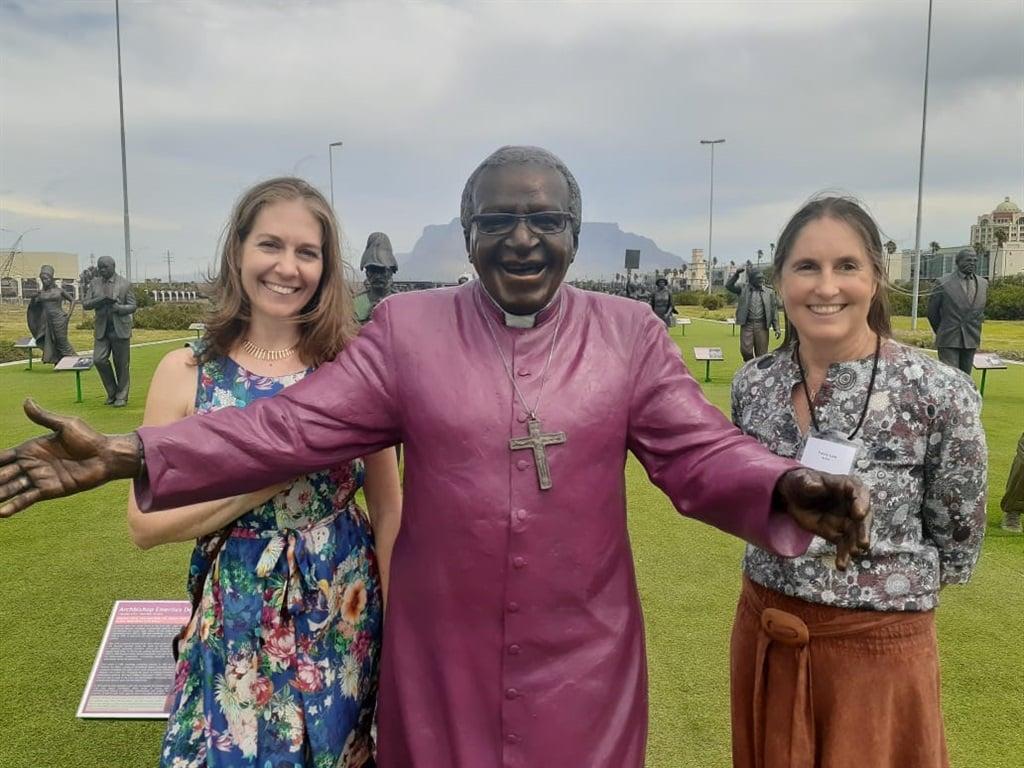Africa-Press – South-Africa. When the statue of the late Archbishop Emeritus Desmond Tutu was unveiled in Cape Town on this week, artists Cristina Salvoldi and Tania Lee didn’t admire their handiwork. Instead, they looked at the tears in the eyes of Tutu’s family members.
“That’s how we know if we’ve done well,” said Lee.
The statue of the Arch, as Tutu was popularly known, will join 100 other bronze statues of iconic resistance leaders at the Long March to Freedom exhibition, housed in Century City.
Creating the life-size sculpture was a rush of activity, and the artists had only a few months to create a maquette (smaller scale model) and life-sized version of the sculpture before it was cast in bronze.
Salvoldi and Lee have worked together for almost a decade and have created several other sculptures for the exhibition. But none matched the pressure in recreating the image of one of South Africa’s most well-loved struggle icons.

Salvoldi said much of the work went into the maquette, deciding the details such as age, posture and the accessories that the statue would have.
Once that was approved, “the blowing up process” scaled it into a life-sized version, and the artists spent hours poring over details like wrinkles, pleats and hair.

Salvoldi and Lee decided to use images of Tutu from his mid-sixties, as they felt he would be most recognisable to the public at that stage, having already been named archbishop emeritus and having chaired the Truth and Reconciliation Commission.
“We thought about what we wanted to portray and what he represented. We wanted him to be joyful and welcoming,” said Lee.
After pouring over hundreds of images and hours of video footage, the artists selected a pose Tutu often assumed – his arms outstretched, a wide smile on his face, striding forward to meet people in his cardinal robes.
“Every time he did this pose, his fingers did a very specific thing. That’s something you pick up when you look at photos. You’re trying to get those personal details in,” said Salvoldi.
Lee added:
Lee said that while there was pressure to do the Arch’s memory justice and produce a sculpture that would hold up to the scrutiny of the public, the project was “exciting”.
“What was wonderful about creating a sculpture of him, is that he’s such a light figure. He was so approachable,” said Lee.
The artists were offered a wealth of support, with the Desmond and Leah Tutu Foundation allowing them to draw on resources such as robes, video footage and hand casts.
“Through the process, you’re looking for that recognition. You’re looking for the moment when you go, ‘Yes, he’s arrived. He’s there’,” said Lee.
Salvoldi added: “Towards the end of the process, you’re just moving tiny pieces of clay. And then it just twigs.”
Tutu’s family were visibly emotional at the unveiling, touched by the likeness to their father and grandfather. His granddaughter, Nyaniso Burris, described the statue as “a beautiful rendition”, adding that the statue “felt like him”.
Speaking at the unveiling, Dali Tambo, CEO of the National Heritage Project (NHP), said Tutu’s wife, Leah, had seen the sculpture prior to the unveiling but was so emotional at the likeness captured that she was unable to get out of her car.
Sarah Haines, director of the NPC – the owners of Long March to Freedom – said the project was one of the fastest commissions they had worked on.
“This one was fast turnaround. We wanted to make Human Rights Month (for the unveiling). Woolworths committed the funding in November 2022, and we got going immediately. The foundry was under serious pressure to complete as they only had a month to cast. Typically, a bronze of this nature would take four to five months from start to finish,” said Haines.
Salvoldi and Lee had a few weeks to develop the maquette and life-size sculpture before handing it over to the foundry – something the artists described as “nerve-wracking”.
The sculpture was cast by the Loup Fine Art Foundry in White River, Mpumalanga, and had a long journey to its home in Cape Town, wrapped up and transported on the back of a flatbed truck.
According to Haines, around 200kg of the alloy ingots would have been required to cast the mould. The final piece weighs 158kg.
For More News And Analysis About South-Africa Follow Africa-Press






